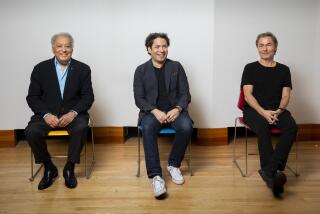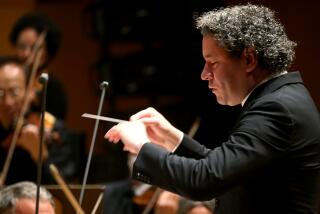LACO, with a skitter and a thunk
Edgar Meyer correctly notes that there isn’t a whole lot of music for double bass and orchestra, so he has set about trying to create a repertoire himself. The protean bassist-composer already has written two concertos -- and he, Jeffrey Kahane and the Los Angeles Chamber Orchestra performed the second one at the Alex Theatre in Glendale on Saturday night.
However, the Meyer Double Bass Concerto No. 2 has had a rather complex history already. Having unveiled the piece in 2003, Meyer became dissatisfied with the first two movements, rewriting them completely. He also collaborated with the Nashville Symphony’s inventive percussionist/instrument builder Samuel Bacco on a huge new mallet percussion instrument, which consists of 73 white polyvinyl-chloride pipes tuned in quarter-tones. It looks like several stacks of rolled paper towels, and it doesn’t have a name yet, so we’ll just refer to it as That Thing.
The strangest aspect of this strange work -- a West Coast premiere in its 2006 version -- is how two massive instruments like the double bass and That Thing can make such little sounds. Meyer keeps his own part at a pianissimo level -- legato and mournful in the new movements, quietly skittering around in the finale -- and Bacco produced dry, hollow, subdued thunks from his contraption.
At one point in the second movement, Meyer and Bacco are left alone in a jazzy quarter-tone jam episode, and the orchestral tuttis in the first movement have a Balinese flavor. That’s typical of Meyer; he doesn’t mind throwing in everything from his multifaceted experiences. Ultimately, it’s a low-key, almost self-effacing piece whose reticence masks its audacity.
Kahane had the superb taste to match Meyer’s piece with two of the best things the 20th century had to offer -- the suites from Copland’s “Appalachian Spring” and Stravinsky’s “Pulcinella.” Kahane used Copland’s original 13-piece chamber scoring and conducted it from the piano, and though one missed the atmosphere of the orchestral version, Kahane achieved some nice sustained moments.
“Pulcinella,” the irresistible birth certificate of Stravinsky’s so-called neoclassical period, was beautifully played, a little slow at times, but with a jolt of energy down the stretch.
More to Read
The biggest entertainment stories
Get our big stories about Hollywood, film, television, music, arts, culture and more right in your inbox as soon as they publish.
You may occasionally receive promotional content from the Los Angeles Times.










